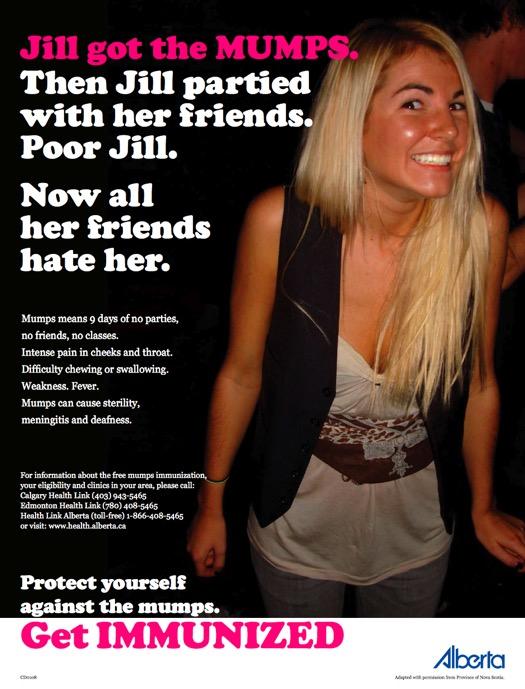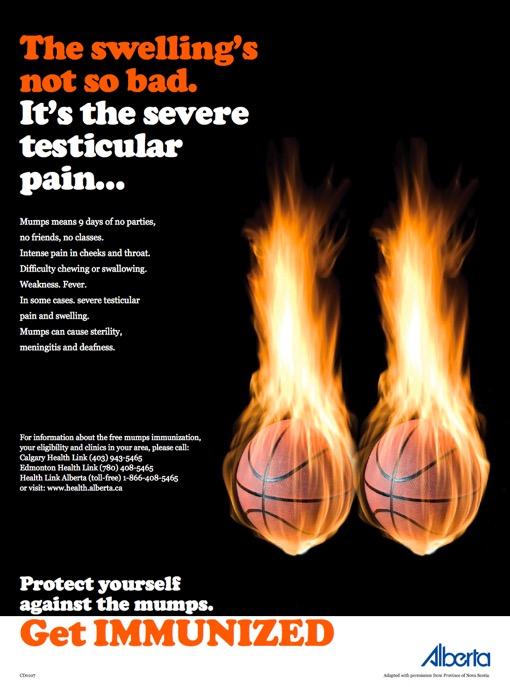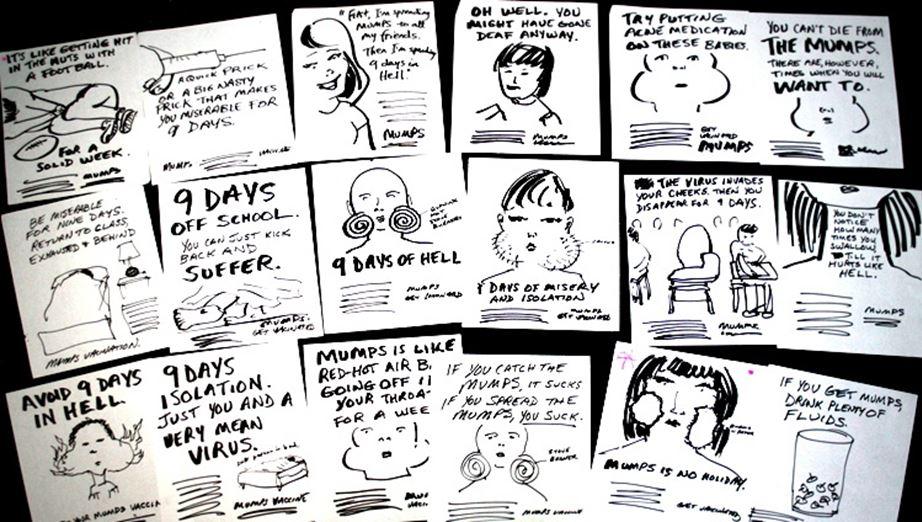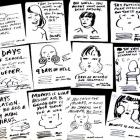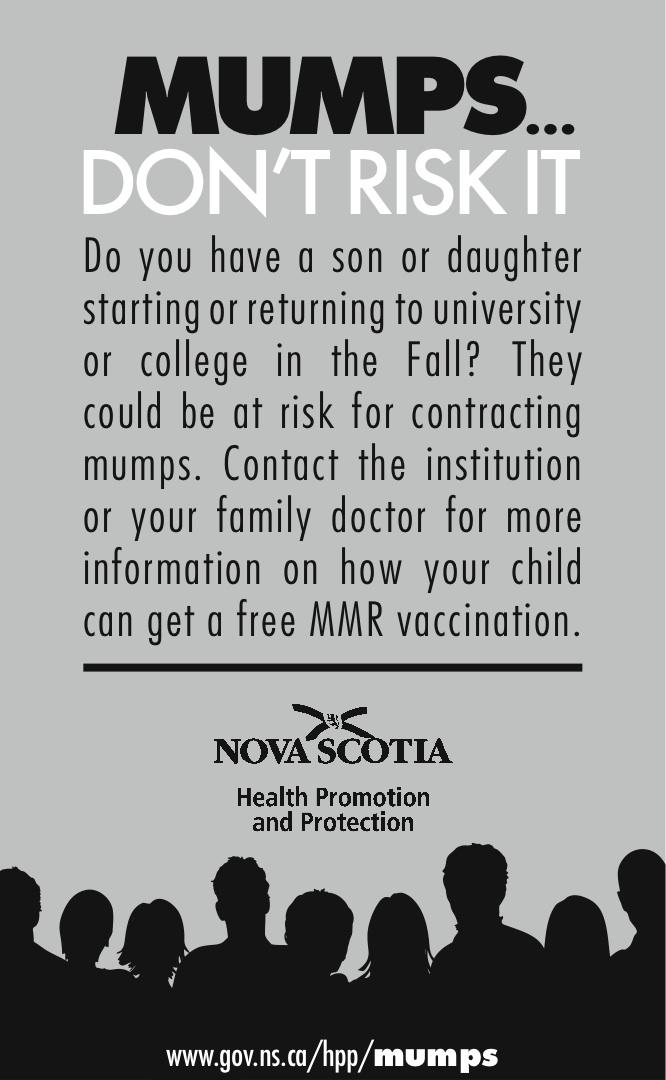
Nova Scotia Health Promotion and Protection Ad. This ad shows the approach initially taken by Nova Scotia Health Promotion and Protection to get the attention of parents and students returning to post-secondary schools and encourage them to obtain mumps vaccinations.
Nova Scotia Health Promotion and Protection Ad. This ad shows the approach initially taken by Nova Scotia Health Promotion and Protection to get the attention of parents and students returning to post-secondary schools and encourage them to obtain mumps vaccinations.
 This work is licensed under a Creative Commons Public Domain Mark 1.0 License.
This work is licensed under a Creative Commons Public Domain Mark 1.0 License.
Mumps is a viral infection spread through direct contact (e.g., kissing, shared cutlery). In children mumps is benign. In adults, mumps carries the threat of sterility. Mumps is communicable for ~7 days before and ~9 days after symptoms manifest and can spread quickly in crowded environments, particularly campuses where students are studying, eating, and socializing. Mumps vaccine (MMR) was introduced to Canada in 1969 and became a required single-dose childhood immunization, leading to a 99% drop in incidence nationwide. It later became evident that a single dose of MMR vaccine does not confer full lifetime immunity, resulting in the proportion of reported mumps cases in individuals aged >20 transitioning from 14% in 1988–1990 to 64% in 2003–2005.
In 2007–2008 mumps re-emerged in Canada among susceptible individuals, namely post-secondary students who had only one dose of the MMR vaccine. With thousands of students on Alberta campuses each day, fear arose that an outbreak of mumps might occur. Alberta Health Services (AHS) initiated a vaccination program to provide a second dose of MMR vaccine to vulnerable students. In an attempt to precipitate timely immunization, AHS co-opted two sex-specific mumps ads previously employed in Nova Scotia.
Mumps vaccination ads have historically targeted parents as the primary decision makers for childhood health. With the onset of mumps in campus environs, the focus of advertising shifted. Post-secondary institutions form a unique social environment in which many young adults take on full responsibility for their own health for the first time. To engage this new responsibility a mumps ad campaign directly targeting students was needed. As Simon Chapman in A–Z of Public Health Advocacy notes, “the use of analogy, metaphor, and simile can be powerful ways of efficiently and memorably translating your issue into concepts and comparisons that are likely to mean more to people.”
To encourage students to obtain mumps vaccination, two sex-specific ads known as “Jack” and “Jill” were employed by AHS. These ads deviate from more traditional vaccination ads in that their graphic imagery plays on the assumed social concerns of students regarding stigma, virility, and socializing. The “Jack” ad depicts a pair of burning basketballs with the slogan “the swelling is not so bad. It’s the severe testicular pain….” The “Jill” ad depicts a young female with the slogan “Jill got the MUMPS. Then Jill partied with her friends. Poor Jill. Now all her friends hate her…” Rather than focusing on mumps as an illness, these ads focus on the perceived social fears of individuals as a prompt for seeking vaccination, overtly implying that, if you have mumps you cannot party, play sports, have sex, or go to class, and that if you spread mumps you will be socially ostracized. Sex neutral drafts of the mumps ads were generated, but were not ultimately chosen.
Both men and women are susceptible to mumps, yet the social messages conveyed by these ads are different. For men the message focuses on the effect on the individual—sore testicles and a potential interruption of sporting and sexual endeavours. For women the message focuses on how other people will see you—namely, they will hate you for giving them mumps. Though effective at prompting record turn-outs for mumps vaccination, these ads speak to larger perceptions of male and female roles in the post-secondary environment, providing an anthropomorphizing element to the mumps virus by painting the campus environment as a differentially contested battleground for men and women on which the threat of dreaded mumps resides.
How to cite
Stark, Robert. “Mumps in the Post-Secondary Environment: Targeted Advertising in the 2007–2008 Alberta Mumps Vaccination Campaign.” Environment & Society Portal, Arcadia (Spring 2017), no. 4. Rachel Carson Center for Environment and Society. https://doi.org/10.5282/rcc/7745.
ISSN 2199-3408
Environment & Society Portal, Arcadia
 This work is licensed under a Creative Commons Attribution 4.0 International License.
This work is licensed under a Creative Commons Attribution 4.0 International License.
2017 Robert Stark
This refers only to the text and does not include any image rights.
Please click on an image to view its individual rights status.
- Briggs, C. L.. "Pressing Plagues: On the Mediated Communicability of Virtual Epidemics." in: Plagues and Epidemics: Infected Spaces Past and Present, edited by D. A. Herring and A. C. Swedlund, 39–59. New York: Berg, 2010.
- Briggs, C. L., and D. C. Hallin. "The Neoliberal Subject and Its Contradictions in News Coverage of Health Issues." Social Text 25, no.4 (2007): 43–66.
- Chapman, S. "A–Z of Public Health Advocacy." In The Fight for Public Health: Principles and Practice of Media Advocacy, edited by S. Chapman and D. Lupton, 127–261. London: BMJ Publishing Group, 1994.
- Goffman, E. Stigma: Notes on the Management of Spoiled Identity. Englewood: Prentice-Hall, Inc., 1963.
- Lupton, D., "Analysing News Coverage." In: The Fight for Public Health: Principles and Practice of Media Advocacy, edited by S. Chapman and D. Lupton, 23-57. London: BMJ Publishing Group, 1994.
- Weber, R. Communicable Disease Epidemiology and Control: A Global Perspective, 2nd Edition. Cambridge: CABI Publishing, 2005.
- Williams, P. "Female Role Portrayals in Print Advertising: Talking with Women about Their Perceptions and Their Preferences." In: NA–Advances in Consumer Research, Volume 22, edited by F. R. Kardes and M. Sujan, 753–60. Provo: Association for Consumer Research, 1995.


